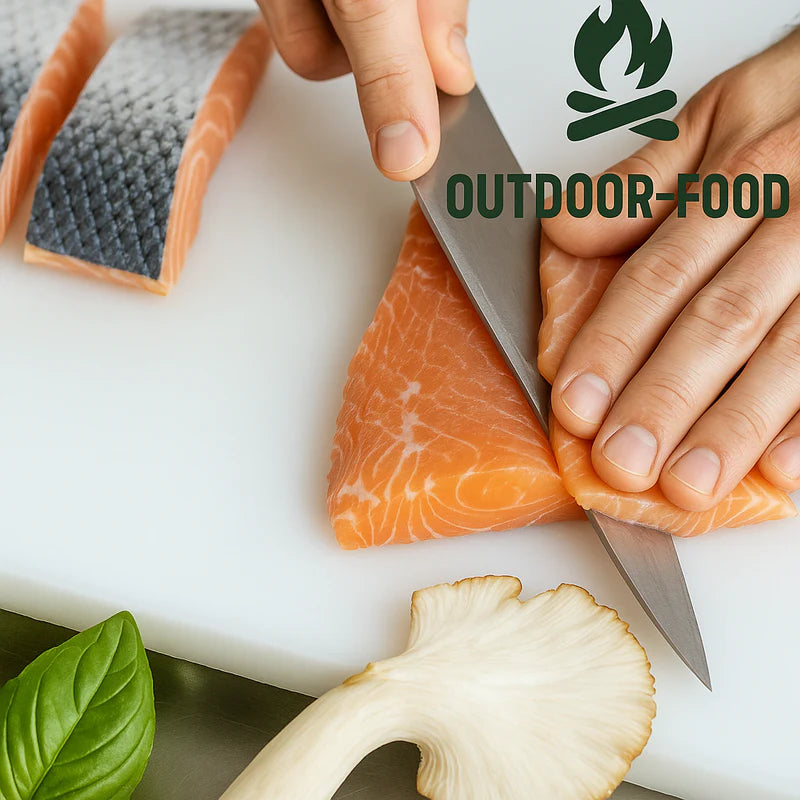
De ultieme gids voor het fileren van vis
Bekijk ons messen assortimentVis fileren

De ultieme gids voor het fileren van vis: stap voor stap uitgelegd
Het fileren van vis lijkt misschien een klusje voor een professionele chef, maar met een beetje oefening én de juiste tools in handen, lukt het ook jou. Of je nu een enthousiaste hobbykok bent of je vangst van het weekend wilt bereiden: met deze gids leer je precies hoe je een vis goed en hygiënisch fileert. En het mooiste? Alles wat je nodig hebt, vind je gewoon bij Outdoor-Food – online of in onze showroom in Capelle aan den IJssel!

Benodigdheden

Wat heb je nodig om een vis te fileren?
Een goed begin is het halve werk. Dat geldt zeker bij het fileren van vis. Zorg dat je onderstaande spullen in huis hebt:
Een scherp fileermes: Kies voor een flexibel fileermes met een dun, vlijmscherp lemmet. Zo snijd je moeiteloos langs de graat en haal je het maximale uit je vis. Bij Outdoor-Food hebben we speciaal geselecteerde fileermessen die perfect zijn voor deze klus. Bestel ze eenvoudig in onze webshop of kom langs in onze showroom aan de Cornusbaan 67A in Capelle aan den IJssel.
Een stevige snijplank: Hygiënisch, stabiel en liefst eentje die je makkelijk kunt schoonmaken.
Schubmes of achterkant van je fileermes
Visgratenpincet (optioneel maar handig!)

Stap voor stap

Stap voor stap een vis fileren
1. Zorg voor een schone werkplek
Hygiëne is alles! Was je handen, reinig je werkblad, snijplank en mes goed met warm water en afwasmiddel. Zo voorkom je kruisbesmetting en kun je veilig aan de slag.
2. Leg de vis stabiel neer
Plaats de vis op een snijplank met de buik naar boven. Zorg dat hij niet weg kan glijden; veiligheid eerst!
3. Schubben verwijderen
Gebruik een schubmes of de achterkant van je fileermes. Werk vanaf de staart richting de kop. Spoel de vis daarna goed af onder koud water.
4. (Optioneel) kop verwijderen
Als je zonder kop wilt fileren, snijd dan net achter de kieuwen de kop eraf met een gecontroleerde beweging.
5. Open de buikholte
Snijd met het puntje van je fileermes van de anus naar de kieuwen. Snijd niet te diep om de ingewanden niet te beschadigen.
6. Ingewanden verwijderen
Gebruik je handen of een visontweker om de ingewanden eruit te halen. Spoel nogmaals goed af.
7. Tijd om te fileren!
Begin bij de rug, achter de kieuw. Maak een inkeping en laat je mes soepel langs de graat glijden, richting de staart. Doe dit met lange, vloeiende bewegingen. Herhaal voor de andere kant.
8. Verwijder graten
Voel met je vingers over het filet en gebruik een pincet om eventuele overgebleven graten te verwijderen. Zo voorkom je vervelende verrassingen tijdens het eten.

Hygiëne

Hygiënetips voor tijdens het fileren
Was je handen grondig en regelmatig.
Reinig je mes en snijplank na elke vis.
Werk op een opgeruimde werkplek.
Raak geen andere oppervlakken aan (zoals je telefoon) tijdens het fileren.
Spoel de vis altijd af voor je begint.

Fileermessen

Fileermessen van Outdoor-Food: kwaliteit die je voelt
Een goed fileermes maakt het verschil. Bij Outdoor-Food vind je messen die speciaal zijn ontworpen voor het fileren van vis. Ze zijn vlijmscherp, flexibel en liggen comfortabel in de hand – precies wat je nodig hebt voor deze delicate klus.
Bestel jouw fileermes online via onze webshop of kom het in het echt bekijken (en voelen!) in onze showroom aan de Cornusbaan 67A, Capelle aan den IJssel.

Conclusie

Conclusie
Vis fileren is niet moeilijk, maar vraagt om zorg, precisie en de juiste uitrusting. Met deze gids ben jij helemaal klaar om aan de slag te gaan. En onthoud: met een goed fileermes van Outdoor-Food wordt het fileren niet alleen makkelijker, maar ook een stuk leuker!
Veel snijplezier – en smakelijk eten!








